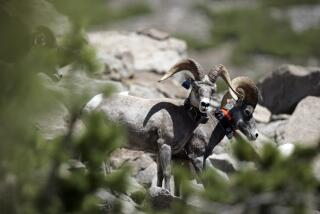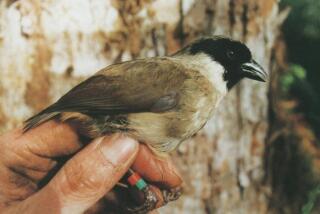There’s Nothing Exotic About Some Endangered Species
- Share via
BANGKOK, Thailand — Conservationists campaign mightily to save the great blue whale and China’s panda. But what about the Taihu pig, the gembrong goat, the choi chicken?
These Asian domestic animals, along with up to 1,500 other farm breeds worldwide, are as endangered as their wild relatives. And their demise could prove equally damaging to man, experts warn.
“Familiarity breeds contempt. Agricultural animals have never enjoyed the romanticism of wildlife,” says David E. Steane, one of the livestock breeding experts alarmed at the loss of farm breeds.
Thus, while biodiversity has become a buzzword among environmentalists, the low-profile pig, cow and chicken are often left out of endeavors to maintain a deep and varied gene pool around the world, Steane says.
Causes for the decline in farm breeds include loss of habitat, population growth and wars, the U.N. Food and Agriculture Organization says.
The greatest threat, however, comes from farmers in poor nations discarding native breeds and switching to Western commercial livestock that is highly productive, the agency says.
But livestock bio-engineered for the technology- and money-intensive agriculture of the West may not be suited to other environments or to the farming methods that the Third World can afford, Steane says.
He heads a pilot project in Asia, home to one-third of the world’s farm breeds, that is trying to halt these barnyard extinctions. It is telling farmers that local breeds may in the long run prove better and more profitable than those marketed by the West.
A “watch list” released by the Food and Agriculture Organization says 105 domestic animals are endangered in Asia.
These include China’s min pig, which is tolerant of extreme temperatures; the pygmy hog in northern India, which is ideal for small villages; and the zebu, a disease-resistant and prolific cattle breed on Java.
Asia is not alone.
The FAO estimates 30% of the 4,000-5,000 breeds of domesticated animals thought to exist around the world are threatened with extinction. It says three breeds are lost forever every two weeks.
In Europe, half of all the breeds that existed at the turn of the century have vanished. More than one-third of all livestock and poultry breeds in North America are considered rare.
Such animals are the result of successful adaptations to environment, some beginning more than 10,000 years ago when man started domesticating animals for food, fiber, work power and fertilizer.
But Western breeds such as Holstein cows, Rhode Island reds and Yorkshire pigs are alluring because they produce greater quantities of meat, milk and eggs. For a poor Asian farmer, who may barely be able to feed his family, these seem heaven-sent.
The problem is that Asian farmers invariably cannot afford the high maintenance and feeding bills of the specialized Western breeds, Steane says. The FAO likens the situation to running a Formula One racing car on diesel fuel.
Developed in laboratories far away, some of the breeds may in the long run prove unsuited to their new environment and knowledge about dealing with their problems is lacking in Asia’s countryside.
As hardy, adaptable local animals fade away and a mono-breed culture sets in, the world loses more of the gene pool that scientists say is crucial to ensuring strong, productive animals in the future.
The loss, for example, of China’s Taihu pig would hurt swine breeders everywhere. The droopy-eared animal averages 16 piglets a litter, compared with 10 for Western breeds, and its meat is tasty and juicy.
A British company has already produced a hybrid of the Taihu, which combines the fecundity and taste of the traditional Chinese breed with more lean meat favored by health-conscious Westerners.
The FAO also worries that should Western imports flounder, Asia will face dire shortages as its population of 3 billion people doubles over the next 30 years and demand for food mounts.
To avert that, livestock experts--like the biblical Noah and his ark--are mounting efforts to save as many breeds as possible. Steane’s four-year, $1.8-million project, financed by Japan, is intended to be replicated in other regions of the world.
When the pilot program ends at the end of 1997, Steane hopes to have an accurate animal genetics databank for the region that will monitor animal diversity in 12 Asian countries.
Those dozen nations--Bhutan, Burma, China, India, Indonesia, Laos, Malaysia, Nepal, Pakistan, Philippines, Thailand and Vietnam--contain half the world’s population.
Steane also sees education as an important role. Most Westerners, having lost their rural roots, are not even aware of barnyard extinctions, while farmers in the developing world must be reminded of the valuable resources running around in their own fields.
“Our role cannot be to keep every breed under the sun--but to ensure diversity,” Steane says.
More to Read
Sign up for Essential California
The most important California stories and recommendations in your inbox every morning.
You may occasionally receive promotional content from the Los Angeles Times.













